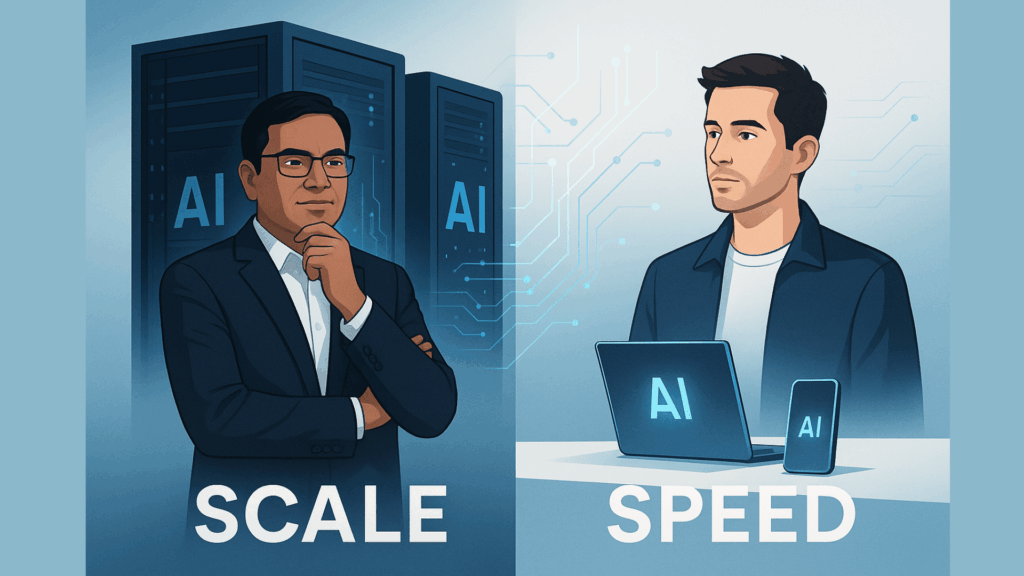Walk into any boardroom today, and you’ll hear the same buzz: Artificial intelligence is no longer a futuristic concept, but a potential gold rush in real time. Forecasts project the global AI market to hit $1.8 trillion by 2030, while others believe the total economic impact could hit $22.3 trillion. If realized, this makes AI the fastest-compounding technology wave since the dawn of the internet.
But beneath the headlines lies a fierce and strategic battle. On one side stand the titans: massive, billion-parameter models like OpenAI’s GPT-4, Google’s Gemini and Anthropic’s Claude. On the other hand, a more agile class of challengers: the small or nano language models (SLMs/NLMs) designed to run everywhere from smartphones to smart fridges.
AI is transforming our world, but who will control and win this potentially trillion-dollar showdown?
The Case For The Titans: Scale Is The New Moat
It’s easy to see why the giants appear unbeatable. Their dominance is built on three fundamental pillars:
1. Unmatched Intelligence And Versatility
Large language models (LLMs) are the general-purpose geniuses of the AI world. Their immense scale allows them to handle complex, multimodal tasks and reason across a vast sea of information in ways that smaller models simply cannot. When GPT-4 was released, it almost immediately became the default benchmark for what intelligence looks like in a machine.
2. The Power Of Capital And Infrastructure
No one can compete with Big Tech’s chips, data centers and talent pools. Microsoft has poured billions into OpenAI. Google has invested a similar amount into Gemini. This is an infrastructure race, and the incumbents have already built a seemingly insurmountable lead. Just last year, over $100 billion in global venture capital flowed into AI companies, with a significant majority of that capital concentrated in mega-rounds for these foundational players. This massive investment confirms that for now, the money is squarely on the side of the giants.
3. The Enduring Law Of Scale
Former Google CEO Eric Schmidt once stated, “There is no evidence that scaling laws have begun to stop.” This is perhaps the most compelling argument for LLM supremacy. The underlying principle suggests that by feeding models more data and compute, they will continue to get better and unlock new, emergent capabilities. The logic here is clear: The most powerful models will belong to the companies with the deepest pockets.
The Rise Of The Underdogs: Agility And Specialization
And yet, history rarely favors a simple continuation of the status quo. The emergence of small and nano models is a direct challenge to the “bigger is better” orthodoxy.
1. Efficiency And Cost
Small models are rewriting the economics of AI. Microsoft’s Phi-3 mini, with a fraction of the parameters of its larger siblings, recently shocked the industry by delivering impressive performance on a range of tasks while requiring far less computing power. This is a game-changer for businesses. The inference cost for a system at the level of GPT-3.5 has dropped over 280-fold since 2022, signaling a dramatic trend toward commoditization and cost-effectiveness that SLMs are leading.
2. Privacy, Latency And The Edge
Running AI on a local device—a phone, a car, a smart appliance—avoids the privacy risks and latency issues of sending sensitive data to the cloud. This is the future of “on-device” AI, and it’s a domain where SLMs are perfectly positioned to win. The market for on-device AI in healthcare, for example, is projected to be a $36 billion industry by 2034.
3. Specialization Over Generalization
A Fortune 500 CFO doesn’t need a model that can write poetry; they need one that can generate precise financial forecasts and run compliance checks. For these narrow, mission-critical tasks, a specialized SLM, fine-tuned on a specific dataset, can often outperform a large, general-purpose LLM. This focused expertise is a powerful competitive advantage in the enterprise market.
The Human Element: Jobs And The Workforce Of Tomorrow
The debate between LLMs and SLMs has profound implications for the global workforce. The World Economic Forum projects that AI may displace 85 million jobs by 2030, primarily in repetitive, process-based roles. However, it will also create 97 million new jobs in areas like data science, AI ethics and prompt engineering, representing a net gain of 12 million. The true impact of AI, then, is not a simple zero-sum game, but a fundamental re-skilling challenge.
So, where does this leave us? The most likely outcome is a hybrid approach. Large models will remain the powerhouse for foundational research, multimodal applications and highly complex, one-off tasks. They will be the “brains” for enterprise-wide copilots and scientific breakthroughs.
Meanwhile, small models will proliferate, embedded in every device, app and workflow. They will handle the routine, repetitive tasks—the high-volume queries.
Preparing For The AI Era
For business leaders, preparing for the AI era starts now. Begin by assessing how AI will reshape roles and where human skills add the most value. Build organizational muscle around AI adoption and governance, and approach implementation strategically rather than reactively.
• Upskill And Adapt: Train teams in data fluency, prompt design and AI tools.
• Build AI Task Forces: Create cross-functional groups spanning tech, legal and operations.
• Start Small, Scale Fast: Pilot high-impact projects, prove ROI, then expand confidently.
Final Thoughts
For investors, this war isn’t academic. If LLMs dominate, value accrues to a handful of mega-players. If SLMs take the crown, the upside shifts to companies building specialized chips, software startups creating tuned nano models and the open-source ecosystems that fuel this new architecture. The giants may win the headlines, but the underdogs could win the wallets. And in the world of technology, the wallets are what build empires.
